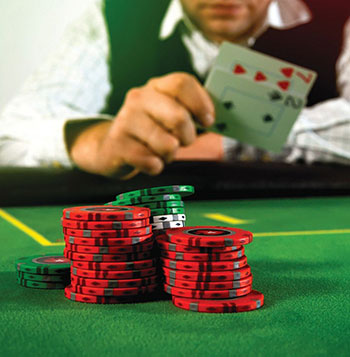THE BLOCKER DEFENSE
Use blockers to become a better poker player
By Jack Clayton
 Block and tackle, anyone? Not the kind associated with fishing or football, but poker. “Blockers” are cards in your hand that limit the combinations of strong hands your opponents may have. It’s defense through simple math. The cards that are visible in your hand and on the board help to narrow the range your opponents possess. It’s a methodical step-by-step plan during each hand to help you figure out what others are holding.
Block and tackle, anyone? Not the kind associated with fishing or football, but poker. “Blockers” are cards in your hand that limit the combinations of strong hands your opponents may have. It’s defense through simple math. The cards that are visible in your hand and on the board help to narrow the range your opponents possess. It’s a methodical step-by-step plan during each hand to help you figure out what others are holding.
For instance, if you’re holding a jack, that’s one less J-Boy your opponent has. There are six different ways to have pocket jacks, but if you’re holding a jack of hearts and a 2 of spades, for instance, then there are only three ways the opponent can get pocket jacks. That’s 50% less, which is a significant mathematical jump, especially if there are a lot of players at one table.
I pick pocket jacks because that’s the one hand that often gives novice poker players more trouble than an ace-king or ace-queen. Despite being a top-5 hand, getting a pair of J-Boys can lead to over- betting without even seeing the flop. When someone calls, suddenly the fear factor can creep in: “Uh-oh, maybe they have a better hand. Did I move too fast? Now what?” Since they wagered too much there’s no turning back, boxing themselves in, which can lead to doubt or tilt. This is why it’s essential to play the percentages and manage your bankroll every hand.
First, let’s look at using a blocker in pre-flop. If you hold a jack and a queen, it vastly reduces the chances that anyone has high end combinations like A-J, J-J, K-Q, Q-Q. So not only are you in a good situation, but it’s more likely that a typically loose player who just made a strong wager is bluffing. You have put some percentages in your favor right off the bat because you reduce combinations of strong hands by your opponents. And since you’re holding J-Q it’s a decent hand, so any call or raise you make is not bluffing – you’re already in a decent position.
If you’re playing last (on the button) with a hand like this, I’d recommend calling to move on to the flop. In addition, using at least one good card as a blocker (A, J, K, Q) helps when you want to bluff, which increases your success rate over the long haul.
Second, here are some ways to use a block post-flop. An effective use of most blocking situations takes place during the third round. If you’re on the river (the third round) and your hand hasn’t improved, the best way to bluff is utilizing blockers. At this point you need to think carefully by calculating what range of cards your opponents have. Yes, this takes practice and a lot of focus, which is why being tired or drinking too many free beverages that can impair your faculties is frowned upon when it comes to advice about winning poker.
You don’t want to be only tuned into your own cards hoping for things to turn in your favor. Instead, you have to be constantly thinking and planning the positions your opponents are in. Poker is a cognitive game for thinking men and women. That means quickly assessing your hand and theirs. What moves might they make? And how much? Is anyone likely to call if you’re about to bluff?
Are you holding cards that can block their hands?
Understanding and using blockers will also keep your bluffing frequency limited. This gives you another edge – a psychological one. By keeping bluffing under control you’re not being type cast as someone who bluffs a lot. This means you’re picking your spots, making your bluffing more effective.
For instance, some players will bluff early and then back out on the river. This tendency will be picked up by astute players quickly and they can start taking advantage of you. At the poker tables you want to be the hunter, not the hunted. So you become a much more effective player by understanding effective blocking cards and utilizing those opportunities.
An example of the value of blockers is that when you are dealt high cards they are blockers to big pairs. If I’m dealt A-J, for instance, and my opponent three-bets me, I’d raise. Having both an ace-blocker and a jack-blocker in my hand decreases the likelihood that my opponent has A-A or J-J. Since there are 12 possible combinations of these strong hands, I’m holding an opening hand that already blocks half of them. I don’t yet have a winning hand, but I’m blocking or limiting my opponents from having more combinations that could top me.
So, I wouldn’t hesitate to move forward as my potential winning options are strong and the others are partially in check.
Understanding and using blockers in conjunction with play is a major part of how the best poker players perform. You are piecing together the puzzle of the strongest hands while narrowing the range of your opponents’ cards.
Because the strongest nuts are the ultimate goal to attain the pot of gold at the end of each hand.


